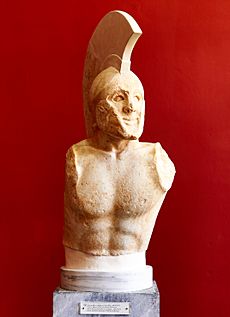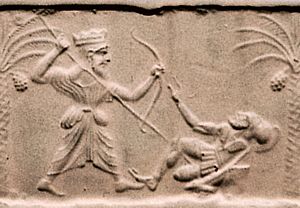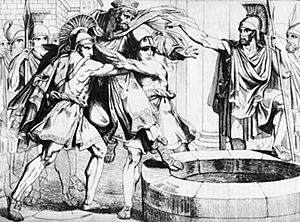Leonidas I facts for kids
Quick facts for kids Leonidas I |
|
|---|---|

Statue of a hoplite (5th century BC), known as Leonidas, at the Archaeological Museum of Sparta
|
|
| King of Sparta | |
| Reign | 489–480 BC |
| Predecessor | Cleomenes I |
| Successor | Pleistarchus |
| Born | c. 540 BC Sparta, Greece |
| Died | 19 September 480 BC (59-61) Thermopylae, Greece |
| Consort | Gorgo |
| Issue | Pleistarchus |
| Greek | Λεωνίδᾱς |
| House | Agiad |
| Father | Anaxandridas II |
| Religion | Greek polytheism |
Leonidas I (died September 19, 480 BC) was a famous king of the Greek city-state of Sparta. He was the 17th king from the Agiad family, which believed they were related to the mythical hero Heracles. Leonidas I was the son of King Anaxandridas II. He became king around 489 BC, taking over from his half-brother, King Cleomenes I. He ruled alongside King Leotychidas. After Leonidas, his son, King Pleistarchus, became king.
Leonidas is most known for his role in the Second Greco-Persian War. He led Greek soldiers in a brave last stand at the Battle of Thermopylae in 480 BC. His goal was to defend a narrow mountain pass from the huge invading Persian army. He died in this battle and became a legend as the leader of the 300 Spartans. Even though the Greeks lost this battle, they managed to push back the Persian invaders the next year.
Contents
Life of Leonidas
According to the ancient writer Herodotus, Leonidas's mother was his father's wife and also his niece. She had not been able to have children for a long time. The ephors, who were five important Spartan officials, tried to convince King Anaxandridas II to get a new wife. But Anaxandridas refused, saying his wife was not to blame.
So, the ephors allowed him to marry a second wife without leaving his first. This second wife soon had a son named Cleomenes. However, a year later, Anaxandridas's first wife also gave birth to a son, Dorieus. Leonidas was the second son of Anaxandridas's first wife. He was either the older brother or twin of Cleombrotus.
Becoming King
King Anaxandridas II died around 520 BC. Cleomenes became king sometime between then and 516 BC. Dorieus was very upset that the Spartans chose his half-brother over him. He left Sparta and tried to start a new colony in Africa, but it failed. Then he went to Sicily, where he was later killed.
We don't know much about Leonidas's relationship with his older brothers. But he married Cleomenes's daughter, Gorgo, before he became king in 490 BC.
Leonidas was a full citizen, called a homoios, when he was chosen to be king. His older half-brother, King Cleomenes, had already been removed from power because people thought he was mentally unwell. Cleomenes had gone into exile when Athens asked for help against the First Persian invasion of Greece. This invasion ended at the Battle of Marathon in 490 BC.
The ancient writer Plutarch wrote that someone once told Leonidas, "Except for being king, you are not better than us." Leonidas replied, "But if I were not better than you, I would not be king." This showed that Leonidas believed he had proven himself worthy to rule through the tough Spartan training, called the agoge.
In 481 BC, Leonidas was chosen to lead the combined Greek forces. Their mission was to fight against the Second Persian invasion of Greece. This choice showed how much the other Greek states respected Sparta's military skills. It also showed they trusted Leonidas as a leader.
This important decision led to Leonidas's death at the Battle of Thermopylae in 480 BC.
Battle of Thermopylae
When the Greek forces asked Sparta for help against the Persian invasion, Sparta asked the Oracle at Delphi for advice.
In August 480 BC, Leonidas left Sparta to face Xerxes's army at Thermopylae. He had a small force of 1,200 men, including 900 helots (Spartan slaves) and 300 Spartan hoplites (citizen soldiers). Other Greek city-states joined him, bringing the total army to about 7,000 soldiers.
There are different ideas about why Leonidas had such a small force of Spartans. Herodotus said that the Spartans sent these men ahead. This was to show other Greek allies that they should not be afraid and should join the fight. The main Spartan army planned to come later, after their religious festival, the Carneia, was over. The Olympic Games were also happening at the same time. Many modern historians are not fully satisfied with this explanation. Some point to possible disagreements within Sparta.
No matter the reason, the total Greek force defending the pass of Thermopylae was between four and seven thousand. They faced a huge Persian army led by Xerxes I. Herodotus claimed this army had over two million men. Modern experts believe it was more like 70,000 to 300,000 soldiers.

Xerxes waited four days, hoping the Greeks would leave. Finally, on the fifth day, the Persians attacked. Leonidas and the Greeks fought back the Persian attacks for two days, killing about 10,000 enemy soldiers. The Persian elite unit, known as "the Immortals," was held back. Two of Xerxes's brothers died in the fighting.
On the seventh day (August 11), a Greek traitor named Ephialtes showed the Persian general Hydarnes a secret mountain path. This path led to the rear of the Greek position. At this point, Leonidas sent away most of the Greek troops. He remained in the pass with his 300 Spartans, 900 helots, 400 Thebans, and 700 Thespians. The Thespians chose to stay, saying they would not leave Leonidas. Their leader was Demophilus. Herodotus wrote, "Hence they lived with the Spartans and died with them."
One idea from Herodotus is that Leonidas sent the others away to keep them safe. He might have wanted to save those Greek soldiers for future battles. But he knew the Spartans could never leave their post. The soldiers who stayed behind were meant to protect the escape of the others from the Persian cavalry. Herodotus himself thought Leonidas gave the order because he saw that the allies were losing hope. He wanted to save the glory of the fight for the Spartans.
Of the small Greek force, attacked from both sides, almost all were killed. Only the 400 Thebans surrendered to Xerxes without a fight. When Leonidas was killed, the Spartans fought hard to get his body back, pushing back the Persians four times. Herodotus says that Xerxes ordered Leonidas's head to be cut off and his body to be put on a stake. This was considered a very disrespectful act.
Leonidas's Legacy
Ancient Times
People in Sparta continued to honor Leonidas as a hero until the 2nd century AD.
Thermopylae Monument

A bronze statue of Leonidas was put up at Thermopylae in 1955. A sign under the statue simply says: "ΜΟΛΩΝ ΛΑΒΕ" ("Come and take them"). This was Leonidas's short and famous reply when Xerxes offered to spare the Spartans' lives if they gave up their weapons.
Another statue, also with the inscription ΜΟΛΩΝ ΛΑΒΕ, was built in Sparta in 1968.
Leonidas in Books and Movies
- Leonidas was the name of a long poem written by Richard Glover in 1737. It was later expanded and published in more editions.
- He is a main character in Steven Pressfield's novel Gates of Fire.
- Leonidas appears as the main hero in Frank Miller's 1998 comic book series 300. This comic tells a fictional story of Leonidas and the Battle of Thermopylae.
- The 2006 movie 300 was made from this comic book.
- Helena P. Schrader wrote a three-part series of novels about Leonidas: Leonidas of Sparta: A Boy of the Agoge, Leonidas of Sparta: A Peerless Peer, and Leonidas of Sparta: A Heroic King.
Leonidas in Films
Leonidas has been played by several actors in movies:
- Richard Egan played him in the 1962 movie The 300 Spartans.
- Gerard Butler played him in the 2006 film 300. Tyler Neitzel played Leonidas as a young man in the same film.
- Sean Maguire played him in the 2008 movie Meet the Spartans, which was a funny parody of the 2006 film.
See also
 In Spanish: Leónidas I para niños
In Spanish: Leónidas I para niños


